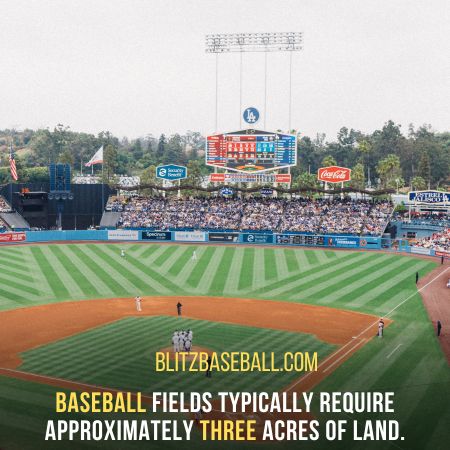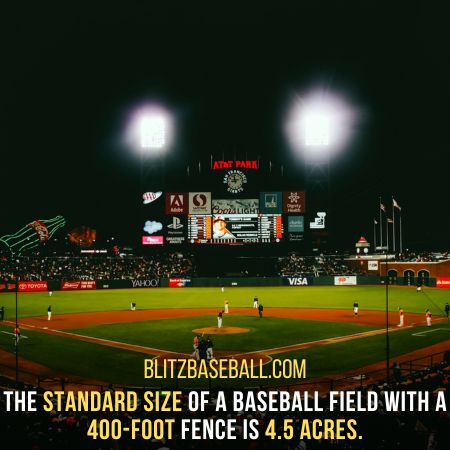Baseball, often referred to as America’s pastime, is a sport that is deeply ingrained in the country’s culture. From the iconic fields of Dodger Stadium to the historic Fenway Park, baseball fields come in various shapes and sizes.
But have you ever wondered how many acres is a baseball field? In this article, we will explore the different sizes of baseball fields, from the standard dimensions to the larger stadiums.
We will also delve into the pitcher-to-batter distances, which evolve as players progress through different leagues.
Additionally, we will discuss the factors that influence the dimensions of a baseball field, such as pitching distances, routing paths, and home run fences.
By understanding these aspects, you will gain a comprehensive understanding of the fascinating world of baseball field dimensions.
So, let’s dive in and discover all the information you need about how many acres make up a baseball field.
Key Takeaways
- Baseball fields typically require approximately three acres of land.
- The standard size of a baseball field with a 400-foot fence is 4.5 acres.
- Softball fields are about half the size of baseball fields, with a 275-foot fence and 2.5 acres.
- The dimensions of baseball fields vary based on the league and available land.
Baseball Field Sizes: How Many Acres Is A Baseball Field?

The size of a baseball field can vary, but typically requires approximately three acres of land and can be as large as 4.5 acres with a 400-foot fence.
Softball fields, on the other hand, are about half the size of baseball fields, with a 275-foot fence and 2.5 acres of land.
When it comes to the cost of construction, building a baseball field can range from $15,000 to over $1.5 million, depending on various factors such as materials used and amenities provided.
As for the largest baseball fields, Dodger Stadium and Fenway Park take the crown with capacities of over 50,000. Other notable large baseball fields include Coors Field, Rogers Centre, Chase Field, and T-Mobile Park.
Despite variations in dimensions and construction guidelines, these fields continue to serve as the stage for the beloved game of baseball.
Pitcher-to-Batter Distances

Pitcher-to-batter distances in baseball vary depending on the age and level of play. For younger players, the distance starts at 46 feet, while in Major League Baseball (MLB), it increases to 60 feet and 6 inches.
The distance between the pitcher and batter is a crucial factor in determining pitcher performance and the success of batters.
To further understand the impact of pitcher-to-batter distances, let’s analyze the batting averages at different levels of play.
| Level of Play | Pitcher to Batter Distance | Batting Average |
|---|---|---|
| Little League | 46 feet | .250 |
| High School | 60 feet | .275 |
| College | 60 feet and 6 inches | .280 |
| MLB | 60 feet and 6 inches | .250 |
| Professional | 60 feet and 6 inches | .265 |
As the pitching distance increases, batters tend to have a slightly higher batting average. This may be due to the additional time batters have to react to the pitch.
However, other factors such as pitcher skill, pitch selection, and batter technique also play significant roles in determining batting averages.

Factors Affecting Dimensions
Factors affecting the dimensions of a baseball field include pitching distances, routing paths, and the placement of home run fences.
These factors are essential in creating a playing field that accommodates the age of players and the strength of hitters.
Pitching distances, for example, play a significant role in determining the overall size of the field. As players get older, the distance between the pitcher and the batter increases, requiring a larger field to maintain fair gameplay.
Additionally, the strength of hitters influences the placement of home run fences. If a league consists of powerful hitters, the fence may need to be set at a greater distance to provide a challenge.
Ultimately, the dimensions of a baseball field are carefully considered to ensure an appropriate playing environment for all involved.
Frequently Asked Questions
How are baseball fields maintained and kept in good condition?
Baseball fields are maintained and kept in good condition through proper drainage systems and regular grass maintenance. Effective field drainage prevents water accumulation and ensures a dry surface, while grass maintenance involves mowing, fertilizing, aerating, and irrigating to promote healthy turf.
What are the dimensions of the infield and outfield areas of a baseball field?
The dimensions of a baseball field’s infield and outfield areas vary based on league and available land. Infield dimensions typically include a 46-foot pitching mound and 60-foot base paths, while outfield dimensions depend on the size of the overall field.
How are the bases and pitching mounds constructed and installed on a baseball field?
Base construction and pitching mound installation in baseball fields involve specific measurements and guidelines. The bases are typically made of rubber and securely anchored to the ground, while the pitching mound is built to regulate height and slope, using clay and soil.
Are there any regulations or guidelines regarding the placement of dugouts and bullpens on a baseball field?
Regulations on dugouts and bullpens are established to ensure the safety of players and coaches. Safety measures may include minimum distances from the field, protective barriers, and adequate seating. Compliance with these guidelines is crucial for the well-being of all individuals involved.
What are the typical materials used for the fencing and backstops of a baseball field?
Typical fencing materials used for a baseball field include chain link, vinyl-coated chain link, and mesh. Backstops are typically made of chain links or netting. These materials provide durability and visibility while ensuring player and spectator safety.
